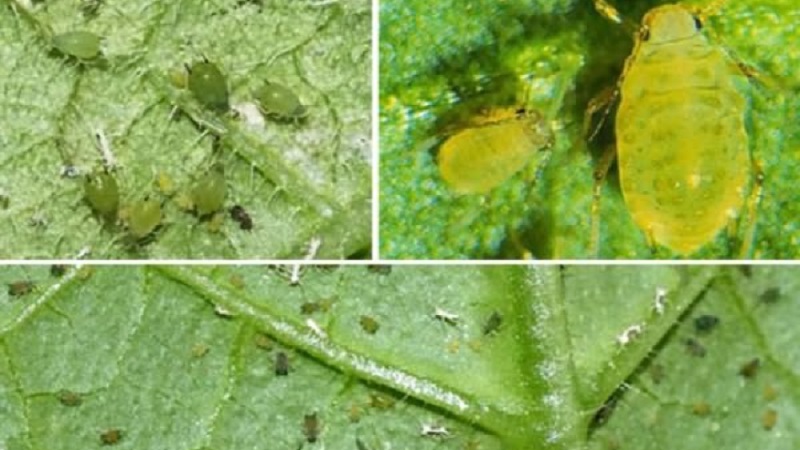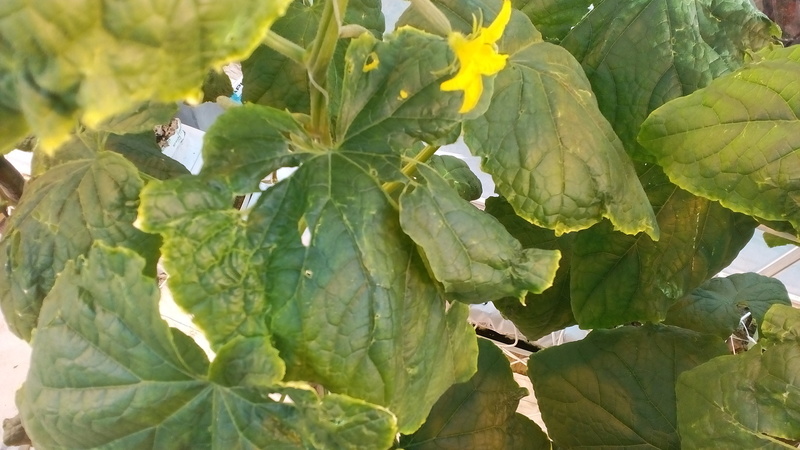How to process cucumbers from aphids during fruiting?
Aphids can appear on cucumbers with any cultivation method. In open beds, infection occurs in July, in greenhouses in spring. The pest is most often found in areas with a humid and warm climate. In such conditions, insects actively reproduce.
To protect plantings during the period of active fruiting, folk remedies and biological products that are safe for plants and humans will help. In the article we will talk about the signs and causes of damage, ways to get rid of aphids and preventive measures.
The content of the article
Aphids and the danger to cucumbers
The melon or cotton aphid (Aphis gossypii) is a representative of the genus Aphids, polyphagous and cosmopolitan. Distributed everywhere. The type of development is incomplete cyclical. Females do not need males to reproduce. Larvae and adult wingless individuals leave for the winter. The generation of virgins consists of winged and wingless insects.
 In the spring they wake up, begin to actively multiply, filling the space around. The bugs feed on the sap of the leaves, which leads to the complete depletion of plants.
In the spring they wake up, begin to actively multiply, filling the space around. The bugs feed on the sap of the leaves, which leads to the complete depletion of plants.
Important! If you do not take measures to combat the pest, you can lose your crop.
What aphid affects cucumbers
Planting cucumbers in closed and open ground affects aphid green and black color. The bugs are 2-5 mm long. The body is soft, covered with growths and hairs of different lengths. The antennae are located on the forehead, on them are the organs of touch.
The oral apparatus is represented by the proboscis, with which the aphid bites through plant tissues and sucks out the juice. Legs - long and thin, perform walking and jumping functions. On the abdomen, there are juice tubes that secrete honeydew.
The insect adapts to all weather conditions. Asexual females reproduce at lightning speed. During the summer period, they lay 50 eggs at a time.
Colonies accumulate on the upper leaves, the lower ones are too dense for them. Therefore, surface treatments are sufficient to kill insects. In spring, when the air warms up to +5 ° C, the aphid activates.
Reference. Drinking the juice from the leaves, aphids release a sticky bloom, which leads to a violation of photosynthesis and the development of a bacterial infection.
Signs
Signs of aphid damage to cucumbers:
- retardation of plant growth and flowering;
- the upper leaves wither, then dry and curl;
- honeydew appears on greenery;
- hordes of ants in the area, attracted by honeydew;
- the ovaries fall off;
- the lower leaves wither;
- colonies of green or black insects appear on the back of the leaves.
The reasons
The main cause of planting infection is ants. They are attracted by the sweet honeydew on the leaves. Crawling from place to place, insects carry larvae, infecting new bushes.
Violation of agricultural practices, thickening of plantings, lack of fresh air in the greenhouse, excessive nitrogen content in the soil contribute to the appearance of a pest on the site.
Aphids live in dry weeds and uncleaned plant debris since last season. At air temperatures above +5 ° С, females move to young plantings and begin to lay eggs on the back of the leaves.
Control methods during fruiting
How to get rid of aphids? Dealing with it will take effort, especially when the insect population is rapidly increasing. Modern insecticides and biological products are effective. Folk remedies based on herbs, soda, tobacco shag and ash can scare away pests, but cannot completely destroy.Infusions and decoctions are used during the period of active fruiting, when chemicals are prohibited.
Hand picking is a laborious way to get rid of insects. It is used in case of minor damage to landings.
In parallel, they are fighting ants. Anthills are poured with the "Anteater" agent or boiling water, they constantly loosen the soil in the beds in order to scare away insects that do not tolerate interference in their life.
Marigolds, oregano, daisies, cumin are planted next to cucumbers to attract ladybirds that feed on aphids.
Folk remedies
How to process cucumbers? Folk remedies are used to scare away aphids when ovaries have already appeared on the bushes. For more details, see the table.
| Name | Preparation and application |
| Marigold | Fill a 10 liter container halfway with dry marigold flowers and fill with warm water. After 48 hours, strain and add 50 g of soap shavings. Process the bushes in the evening. |
| Yarrow | 800 g of grass, pour 2 liters of boiling water and leave for an hour. Dilute the concentrate with 10 liters of water before use. |
| Celandine | Pour 500 g of dry grass with 10 liters of water. Leave in a warm place for 48 hours. Treat the plants with a spray bottle. |
| Mustard | Pour 10 g of grain mustard into 1 liter of water. After 48 hours add 1 liter of water and spray the bushes. |
| Dandelion roots | Chop 1 kg of dandelion roots and pour 10 liters of water. After three hours, process the planting. |
| Hot pepper | Chop 3 pods of pepper and pour 10 liters of water. Put the bucket in a warm place for 24 hours, then strain and add 50 ml of liquid soap, 100 g of ash and 5 drops of iodine. Pour the liquid into a container with a spray and treat the plants. |
| Garlic | Chop 300 g of garlic and pour 1 liter of warm water. Close the container with a lid and leave for five days. |
| Horseradish | Chop the roots (10 pcs.) And pour 3 liters of boiling water. After 4 hours, strain, pour the cake with 3 liters of clean water at room temperature. After 2-3 hours, add the liquid that remained after filtering. Before use, mix 200 ml of infusion with 5 liters of water and process the bushes. |
| Onion peel | Soak 100 g of raw materials in 5 liters of warm water overnight. Add 15 ml of liquid soap and stir. |
| Tobacco shag | 400 g of raw materials pour 10 liters of boiling water. Cover the container with a lid and leave to infuse for two days. Before use, add shavings of soap, stir and process the bushes. |
| Wood ash | 100 g of ash and 200 g of shavings of laundry soap, pour 10 liters of water and stir. Add 10 drops of tea tree essential oil and spray the plants. |
| Soap solution | Add 125 ml of liquid soap to 10 liters of warm water and process the planting. |
| Soda | Dissolve 100 g of soda in 3 liters of water, add 25 drops of cedarwood essential oil and spray the plants. |
| Milk whey (kefir) | Apply the product undiluted every day until the aphids disappear. |
| Ammonia | 4 tbsp. l. add liquids to 10 liters of water, mix 40 ml of liquid soap and process the bushes. |
| Vinegar | For 10 liters of water, take 10 tbsp. l. acetic acid 9% and 50 g of shavings of laundry soap. Spray the bushes with a spray bottle. |
Chemical and biological agents against aphids on cucumbers during fruiting

Chemical preparations are not used from the moment the ovaries appear due to the active absorption of toxic substances by the roots and fruits. Such a crop is dangerous to use for food.
These include funds with contact and intestinal action:
- "Decis" takes effect one hour after treatment, is not phytotoxic.
- "Inta-Vir" available in powder and tablet form. Quickly and effectively destroys the pest (protection up to 15 days).
- "Aktara" - enteric-contact preparation of prolonged action (protection up to two months).
- "Tanrek" - a systemic drug with a long period of protection (up to 30 days).
- "Danadim" - a weakly toxic insecticide that eliminates aphids for 48 hours.
- "Confidor" - starts working 72 hours after spraying the bushes, it is considered one of the most effective insecticides against aphids.
Biologicals are just as effective, despite the "bio" prefix. The funds are allowed to be used during the period of active fruiting of cucumbers. Substances do not accumulate in fruits and are harmless to humans.
Considered the best:
- "Bitoxibacillin" - contains bacteria Bacillus thuringiensis var. thuringiensis, which attack the pest, does not harm the environment.
- "Aquarin" - destroys bugs in 48 hours. The tool is used no more than three times per season.
- "Aktofit" and Fitoverm - contain aversectin. The toxin negatively affects the nervous system of the insect and completely paralyzes it. The product is not addictive, unlike chemicals.
- "Entobacterin" - contains the bacterium Bacillus thuringiensis var. galleriae. Destroys the pest in a week.
- "Arrow" - contains bitoxibacillin, which deprives insects of the ability to feed. Kills aphids completely in 10 days.
Prevention
Preventive measures will help prevent infection of cucumber plantings:
- installation of mosquito nets in greenhouses;
- the use of covering material to protect bushes in open beds;
- fighting ants;
- frequent weeding, getting rid of weeds;
- disinfection of seeds in potassium permanganate or "Fitosporin" before sowing;
- soil treatment with copper sulfate;
- disinfection of greenhouses with sulfur checkers;
- alternation of spray preparations so as not to become addictive;
- compliance with crop rotation;
- cleaning plant residues;
- regular feeding cucumbers with mineral and organic fertilizers.
Read also:
Aphids appeared on pepper in a greenhouse.
How and what to process garlic before planting for the winter.
Conclusion
An integrated approach to the destruction of aphids on cucumbers is the key to a successful fight. During the fruiting period, it is forbidden to use insecticides. Toxic substances accumulate in green matter and fruits. The use of such a product leads to general poisoning of the human body.
The alternation of biological products and folk remedies, compliance with the rules of agricultural technology, the destruction of anthills will help preserve the harvest and get rid of the pest.